Grade Level
3 - 5
minutes
15 min - 1 hr
subject
Physical Science
stem practices
Planning and Carrying Out Investigations
Activity Type:
exploration activity, STEAM, Family activity
Most colors that we see are a combination of the three primary colors of light: red, green, and blue. These additive colors can mix together to form other familiar hues such as yellow, magenta, and cyan. Colored lenses change our perception of the world’s colors by acting like filters: they absorb all colors of light except for whatever color the lenses are.
For example, glasses with blue lenses absorb green light and red light but allow blue light (and blue-containing colors such as purple) to pass through into the eye. While wearing blue lenses, objects that normally appear green and red will become harder to see. In other words, when we look through colored lenses, we’re actually seeing what the world would look like with some of the primary colors of light removed.
Make And Test Your Glasses
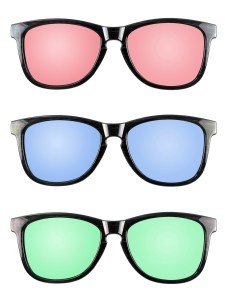
Explore this phenomenon by making a cool pair of color-filtering glasses using tinted cellophane or light filters.
- Print out the attached glasses template on some cardstock and follow the instructions to make frames. Alternatively, you can pop out the lenses of some old sunglasses and use those frames instead.
- Cut out new lenses from colored cellophane or colored light filters. (Don’t have cellophane? Use permanent markers to color plastic wrap or scrap plastic instead!)
– Red, green or blue lenses will have the most dramatic impact on your visual perception.
– The glasses will work better if you use at least three layers of colored cellophane to make each new lens. - Tape your new lenses into your makeshift frames, being careful not to cover the lenses with tape.
- Put on your glasses and explore!
Ask yourself:
- What colored objects become difficult to see?
- What colors are easy to see?
- Are there certain colors that are nearly impossible to see?
Now try on another pair of glasses with lenses of a different color. How do they change what you are able to see?
Investigate Color Filtering
Now try testing your color-filtering glasses more scientifically, using three similar images with differently colored backgrounds. Before you begin, take a look at the images without the glasses. Can you predict how the color of the lenses may change what you see?
- Put on your new color-filtering glasses.
- Scroll down the page and record the number of circles you see in each image.
- Take off your glasses.
Image 1: Red Background
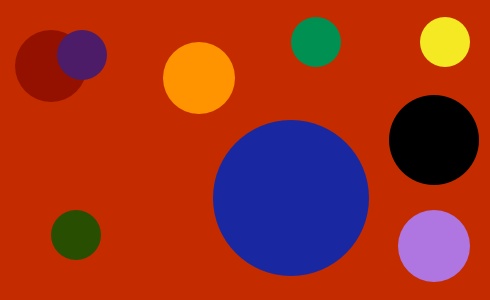
Image 2: Blue Background
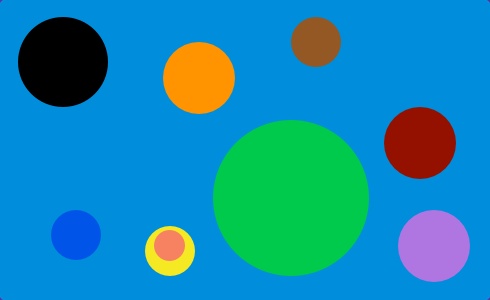
Image 3: Green Background
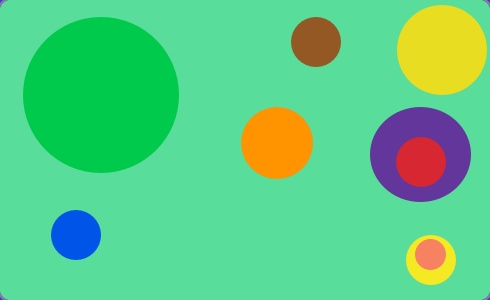
Ask yourself:
- How many circles can you see in each image?
- Which circles were difficult to see, and what do they have in common?
- How did background color influence your ability to see the circles?
What's Happening?
Light is a type of electromagnetic radiation—a form of energy that can travel in waves without other particles to carry it. Visible light, infrared radiation (heat), and ultraviolet (UV) light are all parts of the electromagnetic spectrum. Within the visible light region of the electromagnetic spectrum above, we find the wavelengths for every color of the rainbow. Our eyes and brains interpret different wavelengths of light as colors. Red light has the longest wavelength and violet the shortest. White light is actually a combination of all the colors together.
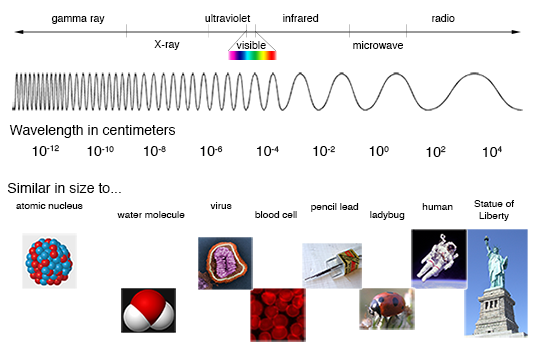
When white light hits a colored object, most of the wavelengths of light are absorbed by the object. Some wavelengths of light are reflected and bounce off the object. So, for example, a red apple absorbs all the wavelengths of light except red. Red wavelengths of light bounce off the apple. Your eyes receive those wavelengths and your brain perceives the apple’s color as red. Weird, right?
When you look through a colored filter, like the glasses you made, the lenses also absorb certain wavelengths of light while allowing others to pass through to your eyes. So, for example, blue filters only allow blue wavelengths to pass through. If you looked at a red apple through a blue filter, what do you think you’d see? Try it, if you can.
Some colors are a mixtures of other colors. Colored filters can help you investigate what colors are made from a combination of primary colors, because they let you block some colors you see. Based on your experiment above, can you figure out what primary colors of light make other colors?
Take It Further
- Listen to Alan Alda on Science Friday discuss his challenge to scientists: define “color.”
- Explore more about the science of color with the TED-Ed video that asks, “What is color?“
- Use this color vision simulator to make a rainbow by mixing red, green, and blue light. Manipulate light filters to change the color of light seen by an observer.
- Did you know we’re still discovering new colors? Learn more about a new color “olo.”
Educator's Toolbox
Meet the Writer
About Ariel Zych
@arieloquentAriel Zych was Science Friday’s director of audience. She is a former teacher and scientist who spends her free time making food, watching arthropods, and being outside.
